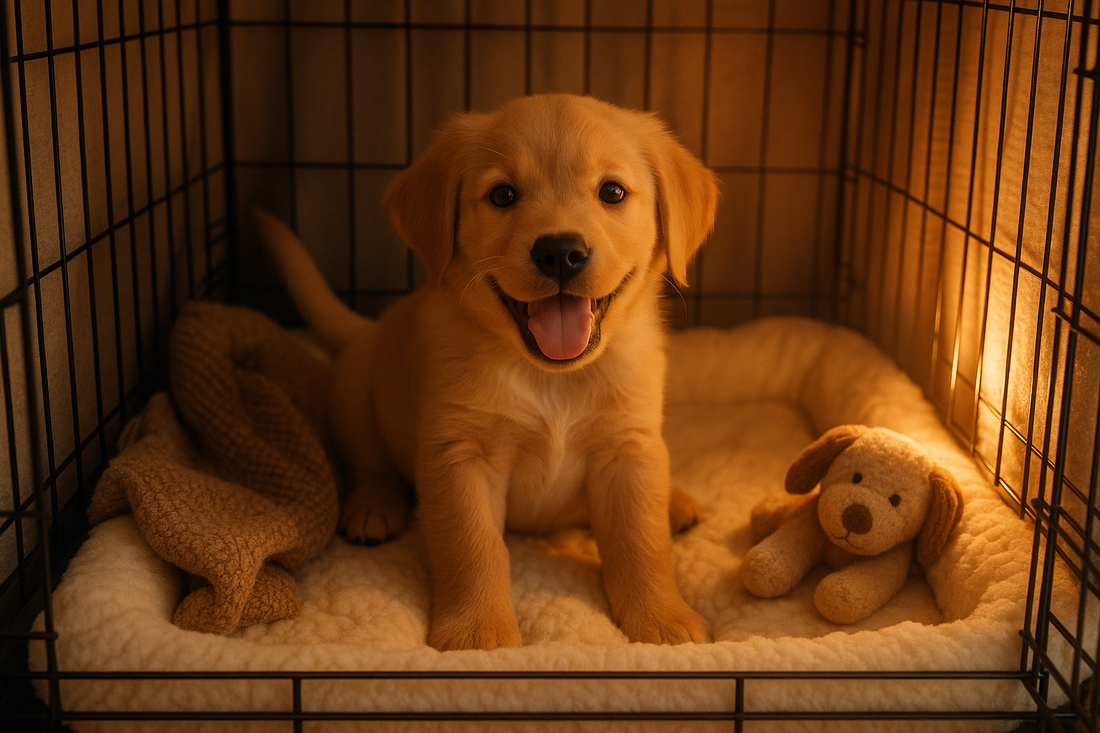
Crate Training 101: How to Crate Train Your Puppy or Dog Safely and Effectively
Share
Bringing a new dog into your home is exciting, but it also comes with big responsibilities. One of the most useful tools you can use to set your dog up for success is crate training. While some people worry that crates feel restrictive, when used correctly, a crate provides a safe, cozy, and comforting space for your dog—like their own little bedroom.
In this guide, we’ll walk you through the basics of crate training, why it matters, and how to do it the right way.
What Is Crate Training?
Crate training is the process of teaching your dog to see a crate as a safe, positive place. A crate is not meant to be a punishment—it’s a den-like environment where your dog can relax, sleep, and feel secure. For new puppies especially, a crate can also help with house training and preventing destructive behaviors when you’re not able to supervise.
Why Crate Training Is Important
- Sense of Security – Crates can provide a sense of safety and security, which is especially important for young pups entering a new environment.
- A Place to Rest – Dogs need downtime. A crate gives them their own quiet retreat.
- House Training Help – Dogs naturally avoid soiling where they sleep. A crate helps reinforce potty training routines.
- Safety – Keeps your pup out of trouble when you can’t watch them (no chewing shoes or getting into dangerous items).
- Travel – A crate-trained dog is likely to be significantly less stressed during car rides or vet visits.
The Potential Pitfalls of Crate Training
- Social Sleepers – Whilst some may claim that crates mimic a dog’s wild instinct to find a den, this is not always the case. Typically, only pregnant females find a den, while other dogs will look to sleep as part of the pack.
- Risk of Separation Anxiety - Some dogs with pre-existing separation anxiety may not do well with crate training. The crate can amplify stress if the dog panics when left alone, leading to destructive attempts to escape.
- Potential For Behavioural Problems – if misused, crates can limit dogs exercise, mental stimulation and time spent forming bonds with people and other dogs, potentially causing them to develop hyperactivity, restlessness and even destructive behaviour
Choosing the Right Crate
Your dog’s crate should be:
- The Right Size – Big enough for them to stand, turn around, and lie down comfortably, but not so big they can use one side as a bathroom.
- Durable and Safe – Wire crates are common for home use, while plastic or soft-sided ones work well for travel.
- Comfortable – Add a soft bed or blanket to make it inviting. Many breeders might provide a towel or blanket with the pup’s moms scent on it, otherwise, one of your worn t-shirts will help provide reassurance and build a bond.
Step-by-Step Guide to Crate Training
1. Introduce the Crate Positively
- Place the crate in a room where the family spends time.
- Leave the door open and let your dog explore at their own pace.
- Toss in treats or a favorite toy to make it appealing.
2. Associate the Crate with Good Things
- Feed your dog meals inside the crate.
- Give high-value treats when they go inside.
- Never force them in—let it be a choice at first.
3. Practice Short Stays
- Once your dog is comfortable, close the door for a few seconds, then let them out.
- Gradually increase the time with the door closed.
- Stay nearby at first, then practice leaving the room for short periods.
4. Build Up Alone Time
- Over days or weeks, work up to leaving your dog in the crate for longer stretches.
- Always make sure they’ve had a potty break, food, and playtime before longer stays.
Common Mistakes to Avoid
- Using the Crate as Punishment – Your dog should never see the crate as a place of fear.
- Leaving Them Too Long – Puppies need potty breaks every 2–4 hours, depending on age. Adult dogs shouldn’t be crated more than 6–8 hours at a time.
- Rushing the Process – Every dog learns at their own pace. Be patient. You should never force your dog into the crate.
- Positive or Negative Reinforcement to Whining or Barking – your pup may whine or bark when shut in their crate. You should never rush to let them out, thus rewarding them for the behaviour, nor should you punish them.
How Long Can a Dog Stay in a Crate?
A good rule of thumb for puppies:
- 8–10 weeks old – 30–60 minutes
- 11–14 weeks old – up to 3 hours
- 15–16 weeks old – up to 4 hours
- Over 6 months – 6–8 hours max
Remember: the crate is not a substitute for exercise, play, and bonding time.
Final Thoughts
Crate training takes time, patience, and consistency—but the rewards can make it well worthwhile. A crate can become your dog’s happy place, giving them comfort, safety, and routine while giving you peace of mind as an owner.
Start slow, make it positive, and remember: your goal isn’t just to train your dog to tolerate the crate—it’s to help them love it.
